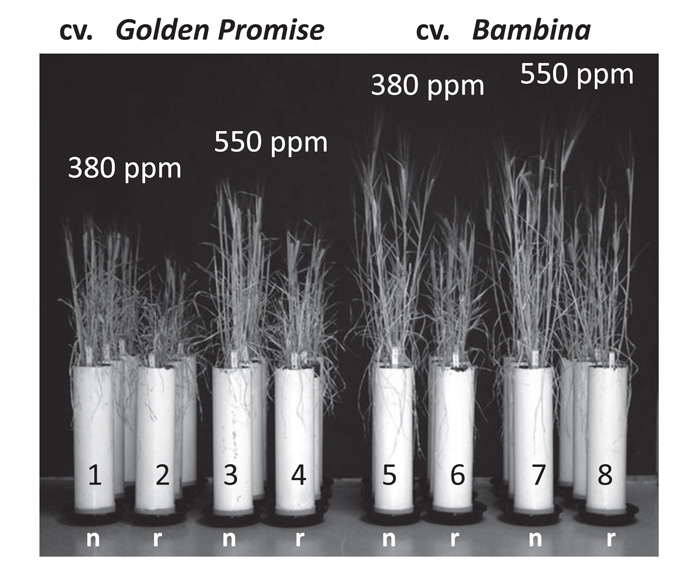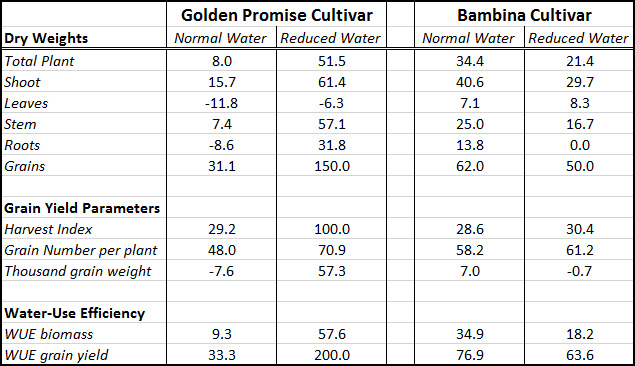| Follow @co2science |
Paper Reviewed
Schmid, I., Franzaring, J., Müller, M., Brohon, N., Calvo, O.C., Högy, P. and Fangmeier, A. 2016. Effects of CO2 enrichment and drought on photosynthesis, growth and yield of an old and a modern barley cultivar. Journal of Agronomy and Crop Science 202: 81-95.
Barley (Hordeum Vulgare) is the world's fourth most important cereal crop after wheat, rice, and corn, making it a central component of the world's food supply. As one of the oldest cultivated grains in the civilized world, it also has a storied history. Egyptians, for example, buried mummies with necklaces of barley. Centuries later, Edward II of England standardized the inch as equal to "three grains of barley, dry and round, placed end to end lengthwise" in 1324 (Klein, 1974).
Barley is also an important health food. It is high in fiber, antioxidants, vitamins and essential minerals. It has more protein than corn, brown rice, millet, sorghum or rye and is lower in soluble (starch) carbohydrates than almost all other whole grains. Furthermore, scientific studies have shown that including barley in one's diet can reduce blood pressure and the risk of many diseases, including heart disease, obesity, and diabetes.
Given the great importance of barley, it is understandable that many people are concerned about the future of this key food crop and how it might respond to future changes in climate and atmospheric CO2. To this end, therefore, a team of seven German researchers (Schmid et al., 2016) recently investigated the effects of elevated CO2 and drought on two barley cultivars, Golden Promise and Bambina. More specifically, they grew the two cultivars in controlled environment chambers at two CO2 levels (380 and 550 ppm) and two water levels (normal and 33% less water) in order to simulate drought conditions, based on average rainfall over the course of the growing season. And what did their study reveal?
As indicated by the data presented in the table below, atmospheric CO2 enrichment bestowed a number of benefits on the two barley cultivars. Grain dry weight, for example, was enhanced by 31 and 62 percent in Golden Promise (GP) and Bambina (BA) cultivars, respectively, under normal water conditions. In reduced water conditions elevated CO2 proved even more beneficial, enhancing BA and GP grain dry weight by 50 and 150 percent, respectively, coming close to fully ameliorating the impact of drought on the two cultivars.
Total plant biomass was also enhanced by CO2 enrichment in both plants under normal (8% for GP and 34% for BA) and simulated drought conditions (52% for GP and 21% for BA) (see Figure 1). Similarly, as shown in Table 1, the water use efficiency of both plants was also enhanced by elevated CO2, including a whopping 200% increase under reduced water conditions for GP when calculated based on grain yield. Most significantly, however, are the findings that pertain to the edible portion of the plant, including grain number per plant and harvest index, which were significantly enhanced by elevated CO2 under both normal and water-stressed conditions.
Thus, in light of all the findings reported by Schmid et al., it would appear that barley plants will benefit from a future rise in atmospheric CO2, especially under water-stressed conditions, where their biomass, water-use efficiency and important grain harvest index will all be enhanced. Barley's prominence as a global food crop, recognized for its several health-related benefits, should therefore continue to aid society well into the future. And that is good news worth reporting!

Figure 1. Response of two barley cultivars, Golden Promise (left side, rows 1-4) and Bambina (right side, rows 5-8), grown under normal (380 ppm) or enriched (550 ppm) atmospheric CO2 concentrations and normal (identified by letter "n" beneath the numbered rows) or reduced (33% less than normal, identified by letter "r" beneath the numbered rows) water supply. The photo shows plants at final harvest, 106 days after sowing. Source: Schmid et al. (2016).

Table 1. Percent change in various growth-related parameters of two barley cultivars in response to a 170 ppm increase in atmospheric CO2 under normal and reduced (33% less) water conditions. Data derived from Schmid et al. (2016).
Reference
Klein, H.A. 1974. The World of Measurements. Simon & Schuster, New York, NY.




